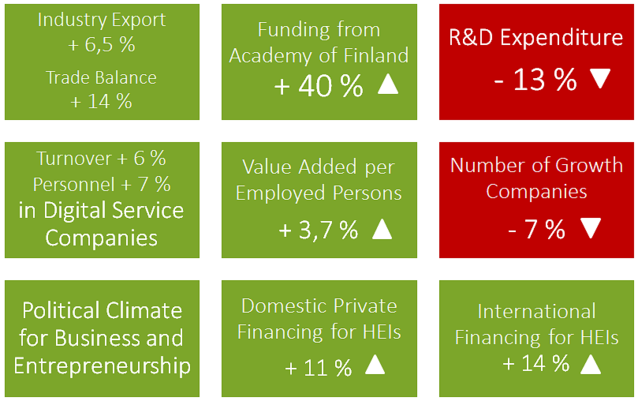The peaking economic trends have manifested themselves as positive news in the Tampere Region. Employment is growing at a record pace and the excellent key figures are very encouraging. Growth strengthens the financial foundation and investment capabilities of companies after the prolonged period of weak growth.
Positive signs are also visible in terms of the pool of expertise in the region, especially as regards institutes of the highest expertise. After some birthing pains, the new University of Tampere is transitioning into a phase of operational activities, under the leadership of a visionary management and with the support of various interest groups. It is testament to the quality of the university’s strength areas and to the appeal of the multidisciplinary opportunities made possible by the fresh community that the member universities have become more successful in competing for the most sought-after domestic and European funding. In future, international funding and cooperation, especially, can be expected to provide plenty of new resources for innovation collaboration in the area.
Still, the positive buzz is overshadowed by two threat scenarios. The familiar one of the two is the dramatic drop in research, development and innovation investments during the entire 2010s. Private RDI investments have no less than halved over the decade. The share of RDI investments in the GDP has even plummeted below 4%, which has been set as the national goal. These figures suggest that the Tampere Region will not be able to hold on to the title of Finland’s lead innovator and concentration of high-tech export for long anymore.
RDI operations can be boosted back to the billions value scale only through justified business investments made by companies. In order to make them happen, we must use all methods of growth policies from creating new ecosystem opportunities to drawing in investments and developing infrastructure. Fresh decisions by high-technology companies to establish themselves in the Tampere Region indicate that this development is possible and our level of competence is still sufficient to stay in the global race.
Another looming threat is the dip in new value creation and start-up activities. The start-up ecosystem in the Tampere Region rose to a new level in the wake of the dissolution of the Nokia cluster. Now, the number of growth companies and the influx of growth funding to the area have slowed down. In addition to this, the ability of innovation environments to support start-up development by means of high-quality services and to entrench growth entrepreneurs in the area has dropped below the optimal level. On a positive note, however, the key supporters of innovation activities have committed to investments and cooperation in the form of a start-up alliance. What needs to happen now is for the planning to progress to practical operations conducted with the entrepreneur community.
During the recent decade, Finnish growth policy has been heavily focused in the country's capital. Although our competence level is first-rate, the development of the region as a concentration of innovation will require better support from national and EU politics. The best way for us to affect them is to work as a unified team.
Petri Räsänen, Director, Innovation and Foresight, Council of Tampere Region
Situational Picture of Innovation 2018 - Contents
- Value Network Capability
- Funding of RDI
- Company Growth
- Higher Education Institutions
- Internationality
- Digitalisation
In depth analyses, blogs and about the process
Tampere Region’s RDI related to social welfare and health care services, by Analyst Piia Tienhaara, Council of Tampere Region
Should we write to Germany instead of Santa Claus? by CEO Harri Kulmala, DIMECC Ltd
Batteries powering up the future, by Project Specialist Johanna Valio, Council of Tampere Region
Hall of Fame: Tampere Region as an influencer in national and international innovation policy
